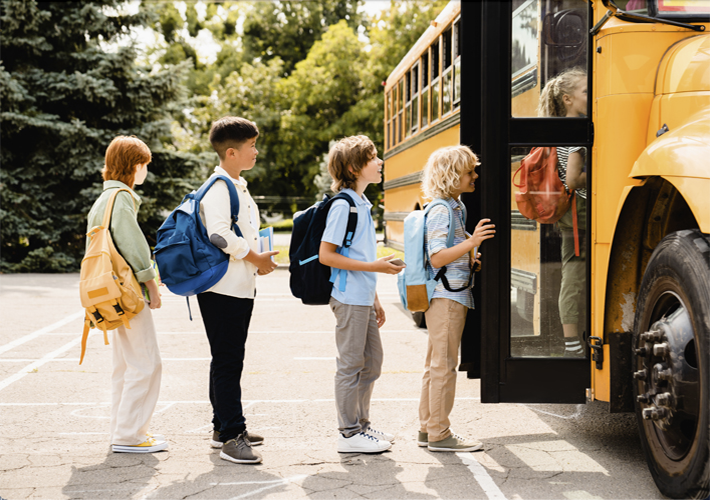
10 Standards for Back to School
The end of summer means the return of school for many people around the world. As students anticipate the next chapter of their education, they also look forward to a fresh start. Back to school sales mean fashionable clothes and brand-new supplies. For parents, a new term also requires planning, as they look over district calendars, learn athletic schedules, plan bus routes, or coordinate after-school care.
Many parents are also thinking about safety, especially in the COVID-19 era. Thankfully, safety standards are at work all around us, even in places we might not expect. ASTM International oversees over 12,000 standards that are in operation all over the globe. Many of them affect school students, whether on the morning commute, in the classroom, on the playground, or at the big Friday night game. Here are 10 ways standards play a role in the lives of students.
1. Morning Routine
Before students even walk out the door, standards are already hard at work to ensure they can safely go about their day. From their beds to the food on the breakfast table, young people can comfortably go about their morning routine thanks to standards. (Parents benefit too, as they already have enough to worry about in the mornings!) And when it’s time to head out, even backpacks are standardized and ready to go.
2. Bus Trips
The bus ride to school is one of the classic rituals of schooling. Each year, more than 20 million students are transported at public expense, and school buses are a particularly important resource for low income students and children who live too far from school to walk. School buses are the most regulated vehicles on the road, and standards affect many components of buses – even the very seats children sit on are tested for fire safety.
3. On the Road
Standards are also necessary outside of vehicles. Many aspects of the environment can represent a safety hazard, and safe road conditions are an especially important factor in transporting students to school. The committee on road and paving materials (D04) has jurisdiction of over 200 standards related to transportation construction and maintenance, from testing asphalt and constructing traffic control materials to the materials used for deicing and statistical procedures.
4. School Security
Once students reach schools, it is paramount that strong security measures are in place to provide for their safety. While parents and administrators alike can find the topic of school security difficult, standards respond to a crucial need to have helpful information and strong plans in place for any emergency situation. Even simple security features such as cameras can have dozens of distinctive elements that require careful choice, such as resolution type, storage space, video retention, and watermarks. Thankfully, the committees on homeland security applications (E54) and security systems and equipment (F12) are carefully thinking about these types of concerns.
5. Toy Safety
Play is an important part of learning, especially in early-childhood education. Just as when children play at home, it is important to know that their toys do not present unnecessary hazards. The committee on consumer products (F15) oversees many products used in the home, from cribs and baby monitors to liquid laundry packets and home swimming pools. The specification for toy safety (F963) relates to possible toy hazards that might not be immediately recognized by the public, helping manufacturers exercise care in designing their products.
6. Take Note
Even in an era when schooling is increasingly technology-driven and virtual, we still need paper. Paper products are in every corner of schools, not only in notebooks, but also packaging and even insulation. Standardizing paper is a big project, whether it concerns paper tearing resistance or the nitrogen content of paper products. Even the committee on soil and rock (D18) oversees testing related to the waste sludges created during paper manufacturing. These standards add up, providing a layer of safety for students every single day.
7. Sports Equipment
Athletics is a major part of education, with over half of U.S. high school students participating in a team sport. These activities promote health, socialization, and fun, but they also contain an element of risk. Standards introduce essential performance and safety guidelines to sports. The committee on sports equipment, playing surfaces, and facilities (F08) has developed over 100 standards related to athletics. These standards cover a wide range of activities, including ice hockey, wrestling and gymnastics, baseball and softball, lacrosse, and fitness equipment
8. The Arts
While English, math, and history are all crucial topics to learn, creativity is also a necessary part of education. Standards also apply to the arts, and there are many standards at work in classrooms, rehearsal spaces, and auditoriums. In fact, these standards affect students in many unseen ways: there are standards to protect art supplies from sun exposure, provide specifications for piano strings, and rate sound insulation.
9. Time for Recess
Few things match the freedom and the fun offered by a break in the school day, and many young students anticipate recess more than any other moment. Both indoor and outdoor play spaces also present risks, but standards help address potential hazards children might encounter during the day. Also overseen by F08, there are dozens of standards for the places children play, from playground surfaces and turf fields to tennis courts and baseball fields.
10. Walkways
When the day is done, students often rush out of the building as fast as they can. Though many receive rides or take the bus, many others walk to and from school. The committee on pedestrian/walkway safety and footwear (F13) oversees several standards related to the ways people get around on foot. In addition to standards for safe walking surfaces and snow and ice hazards, the committee even oversees specifications and test methods related to the performance of our shoes.
 SN Home
SN Home Archive
Archive Advertisers
Advertisers Masthead
Masthead RateCard
RateCard Subscribe
Subscribe Email Editor
Email Editor